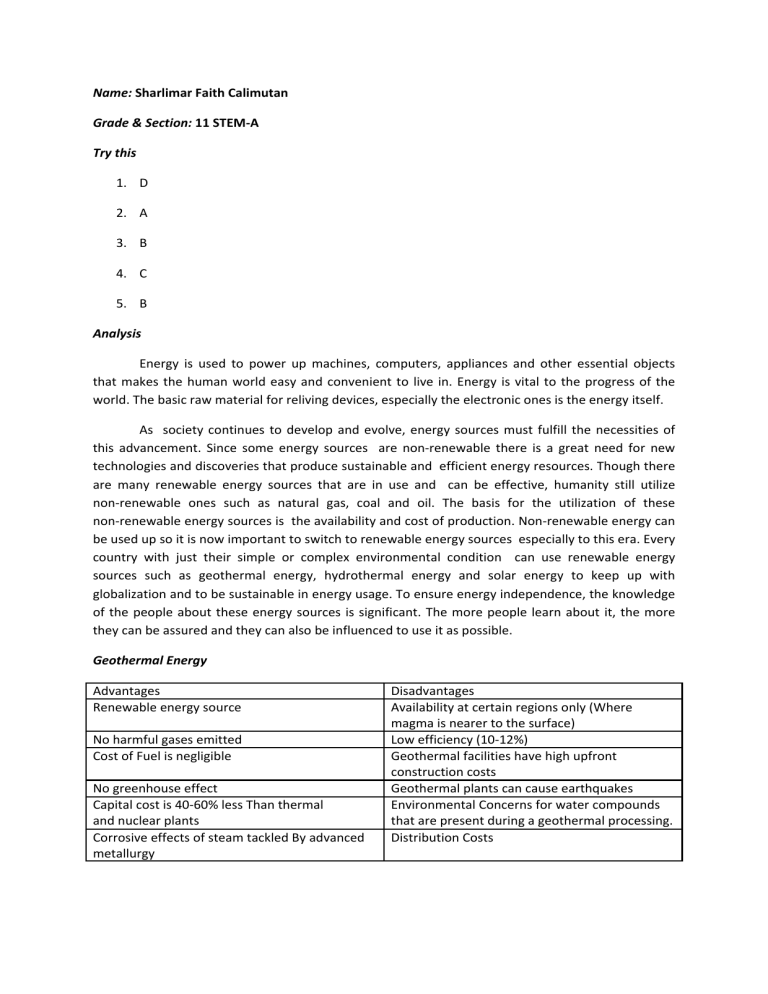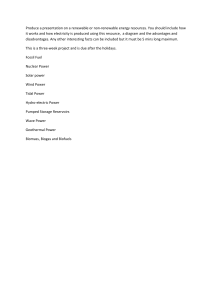
Name: Sharlimar Faith Calimutan Grade & Section: 11 STEM-A Try this 1. D 2. A 3. B 4. C 5. B Analysis Energy is used to power up machines, computers, appliances and other essential objects that makes the human world easy and convenient to live in. Energy is vital to the progress of the world. The basic raw material for reliving devices, especially the electronic ones is the energy itself. As society continues to develop and evolve, energy sources must fulfill the necessities of this advancement. Since some energy sources are non-renewable there is a great need for new technologies and discoveries that produce sustainable and efficient energy resources. Though there are many renewable energy sources that are in use and can be effective, humanity still utilize non-renewable ones such as natural gas, coal and oil. The basis for the utilization of these non-renewable energy sources is the availability and cost of production. Non-renewable energy can be used up so it is now important to switch to renewable energy sources especially to this era. Every country with just their simple or complex environmental condition can use renewable energy sources such as geothermal energy, hydrothermal energy and solar energy to keep up with globalization and to be sustainable in energy usage. To ensure energy independence, the knowledge of the people about these energy sources is significant. The more people learn about it, the more they can be assured and they can also be influenced to use it as possible. Geothermal Energy Advantages Renewable energy source No harmful gases emitted Cost of Fuel is negligible No greenhouse effect Capital cost is 40-60% less Than thermal and nuclear plants Corrosive effects of steam tackled By advanced metallurgy Disadvantages Availability at certain regions only (Where magma is nearer to the surface) Low efficiency (10-12%) Geothermal facilities have high upfront construction costs Geothermal plants can cause earthquakes Environmental Concerns for water compounds that are present during a geothermal processing. Distribution Costs Application: Task 2 Geothermal Energy Description It is an energy source which has both water and heat, the heat beneath the earth (magma) is used to heat the water present inside the earth. Geothermal Energy Working Principle The magma heats the water present inside the earth and increases its temperature greater than 182 degree Celsius. This hot water from the earth is piping to the surface of the earth through hot water wells. The steam from the hot water is separated and made it to strike on the turbine blade and it starts rotating. A Generator is coupled to the turbine also starts rotating and produces electricity. Advantages Disadvantages a) It requires no fuel for its working. 1. The fluid taken out from deep earth contains b) It requires minimal land and fresh water. mixtures of gases such as Hydrogen sulphide c) Geothermal power is a sustainable (H2S), Carbon dioxide (CO2), Ammonia (NH3), source of energy. methane (CH4) and Radon (Rn). If these gases is released, it will contribute to global warming, acid rain, Radiation and noxious smell. 2. It requires emission control system to reduce the exhaust that may be produce form acids and volatile chemicals. 3. The hot water taken out from the geothermal sources is hold in a solution which may contain traces of toxic chemicals like mercury, boron, arsenic, antimony and salt. when water cools these toxic chemicals comes out of the solution and can responsible for the environmental damage if released. 4. Geothermal power plant constructed at the site may adversely affect land stability. Reflect The Earth has been emitting heat for about 4.5 billion years, and will continue to emit heat for billions of years into the future because of the ongoing radioactive decay in the Earth’s core. What are the pros and cons of geothermal heat exchange system in term of safety, comfort and effect on the environment? Reinforcement and Enrichment Electrical Appliances Refrigerator Bulbs Watt Rating Time used (min/day) KWH used/day 131 Watts 300 minutes 6.55 kWH 12 watts 300 minutes 0.6 kWH Cost of use (php/day) at 7.50/ kWH 49.125 php 4.5 php 50” colored television Heater Electric Fan 101 watts 300 minutes 5.05 kWH 1500 watts 50 watts 10 minutes 480 minutes Total 2.5 kWH 4 kWH 18.7 kWH 37.875 php 18.75 php 30 php 140.25 php Questions: 1. What appliances and electrical items does your family usually use on a weekday? On weekdays, since there's pandemic, we are using heaters, electric fan, gadgets and bulbs. We seldom use the refrigerator since we don't really have foods to refrigerate. On weekend?on weekend, the habit is still the same. We use our appliances when we only need it. 2. How much energy do you consume in kWH and in peso? We consume 18.7 kWH per day. In peso, we spent 140.25 per day. Assuming that my family is using coal power plant, we have emitted 28.05 lbs of carbon dioxide to the atmosphere. 3. What can you do in order to lessen the amount of carbon dioxide your family contributes to the atmosphere? In order to lessen the amount of carbon dioxide released to the atmosphere, I have to talk to my family regarding our usage of electricity. So far, I am suggesting that we don't have to use appliances that can have efficient and convenient alternatives. Assess Your Learning 1. B 2. They can only be found at certain places. 3. A 4. B 5. B Try this: Task 1 1. B 2. A 3. D 4. B 5. B Analysis 1. Why care about water? Water is an essential element as to why life emerges on Earth. Because of water, many substances evolved and became what they are today. Water is important to metabolic processes in the human body and it comprises the human bodies for more than 50%. 2. What is the importance of water in Human use and in the society? Water is necessary for continuing growth of industry, agriculture and technology. Water has a vital importance for some of the main functions in the human body . It can be summarized as follows; it is a biological solvent that providesboth the transport and dissolution of vitamins and minerals in the body; it is important in regulating body temperature; facilitates thework of the kidneys and other organs, protects and acts as a cushion;plays a fundamental role in moisturizing the skin, removing toxins and cleansing the body; it supports the conversion of nutrients taken into the body into energy and also helps the absorption of nutrients; water also the main ingredient of carbohydrates, fats and proteins inthe human body. Task 1: Earth is called a blue planet because it is covered with more water than land or continents. From space, Earth can be seen as bright blue. Application Task 2: A. In the first bar, notice how only (1) 2.5% of Earth's water is freshwater - the amount needed for life to survive. B. The middle bar shows the breakdown of freshwater. Almost all of it is locked up in ice and in the ground. Only a little more than (2) 1.2% of all freshwater is surface water, which serves most of life’s needs. C. The right bar shows the breakdown of surface freshwater. Most of this water is locked up in ice, and another (3) 20.9% is found in lakes. Rivers make up (4) 0.49% of surface freshwater. Although rivers account for only a small amount of freshwater, this is where humans get a large portion of their water. Task 3: Break the Water code 1. SEA 2. FRESHWATER 3. GLACIERS 4. LAKE 5. RIVERS 6. STREAMS 7. GROUNDWATER 8. ICE 9. FALLS 10. SALINE Task 4: Water Resources Chart Assess Your Learning What specific water resources found in the locality? Wells Type of Water Resource Rivers (Magapa River) Surface water Igbiating Falls Surface water Groundwater What are the uses ofthis type of water resources? It is used to water the plants, to wash the clothes, to clean the bathroom and toilet, to wash the dishes, etc., mostly to do household chores. It is used to be delivered to houses for their household usage. Sometimes, people also go there to bath and wash their clothes. It is used as a tourist spot. Task 4: Reflect What can you say about this quote “ Ang tubig ay buhay” Water, indeed is life. Many organisms would not exist without needing water. Water is a very important required substance in order to sustain vital activities of human such as nutrition, respiration, circulation, excretion and reproduction. In addition water is also a life space as well as being one of the basic substances in the formation of life environment.




